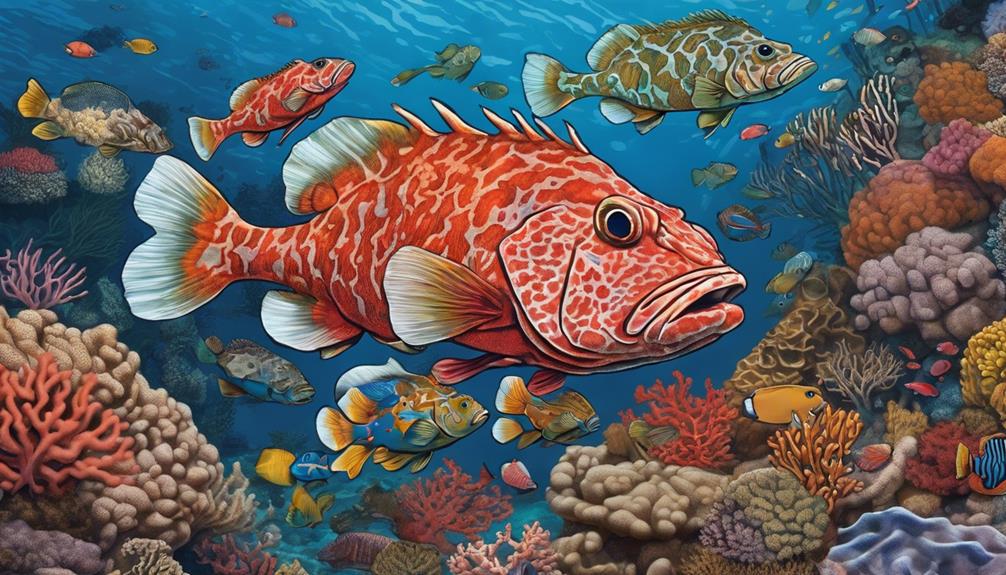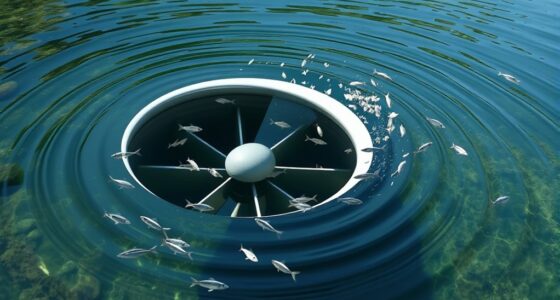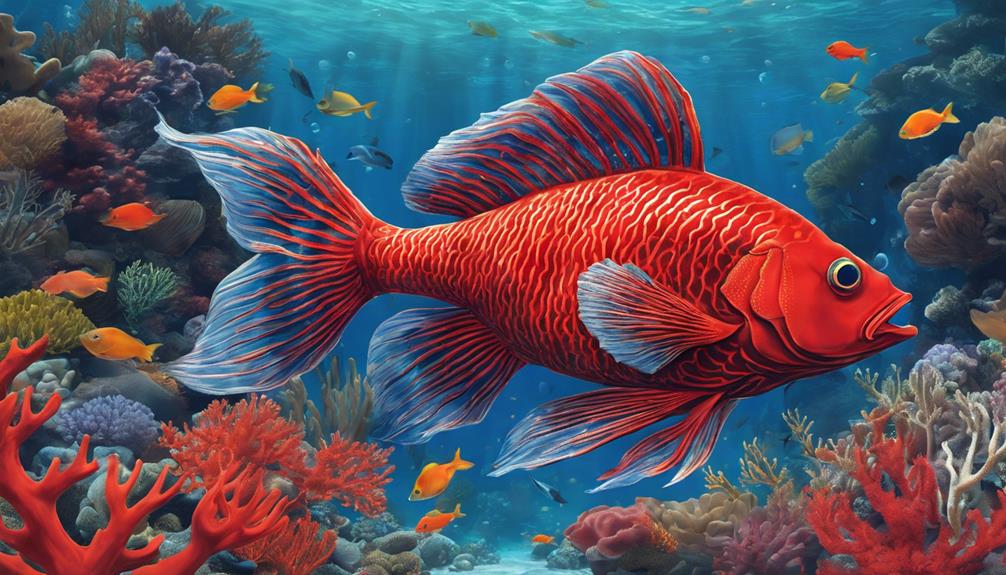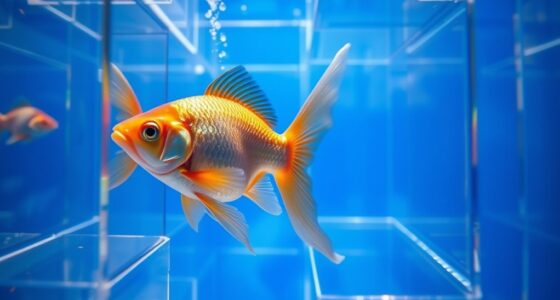I love groupers, they hide in crevices and are essential creatures. They come together for spawning, have various feeding habits, and often hunt alone. They use their strong jaws to catch prey and strike when food appears. Groupers prefer habitats near structures, such as reefs and ledges, in both shallow and deep waters. Recognize them by size variations and habitat preferences. Some common types include Gag, Red, and Black Grouper. Fishing for them requires patience with heavy tackle. Groupers are crucial for marine ecosystems and need protection. Learn more about these fascinating fish!
Key Takeaways
- Consider size, habitat, and behavior for matching
- Look for similar feeding habits and territorial behavior
- Explore diverse grouper species for comparisons
- Identify based on location preferences and physical traits
- Recognize importance in marine ecosystems and conservation efforts
Understanding Grouper Behavior
When targeting grouper while fishing, understanding their behavior becomes essential. Groupers are really good at hiding in crevices or structures, waiting to ambush their prey. This behavior makes it important to place your bait strategically to entice them out.
Additionally, groupers exhibit territorial behavior, often sticking to specific areas for extended periods. By knowing where they prefer to stay, you can increase your chances of a successful catch.
While groupers are usually solitary, they may come together for spawning aggregations during certain times of the year. Being aware of these patterns can help you plan your fishing trips accordingly.
Groupers have varied feeding habits, with some being opportunistic feeders while others have a more specific prey preference. Understanding what type of feeder your target grouper is can guide your choice of bait and fishing technique.
Exploring Grouper Habitat
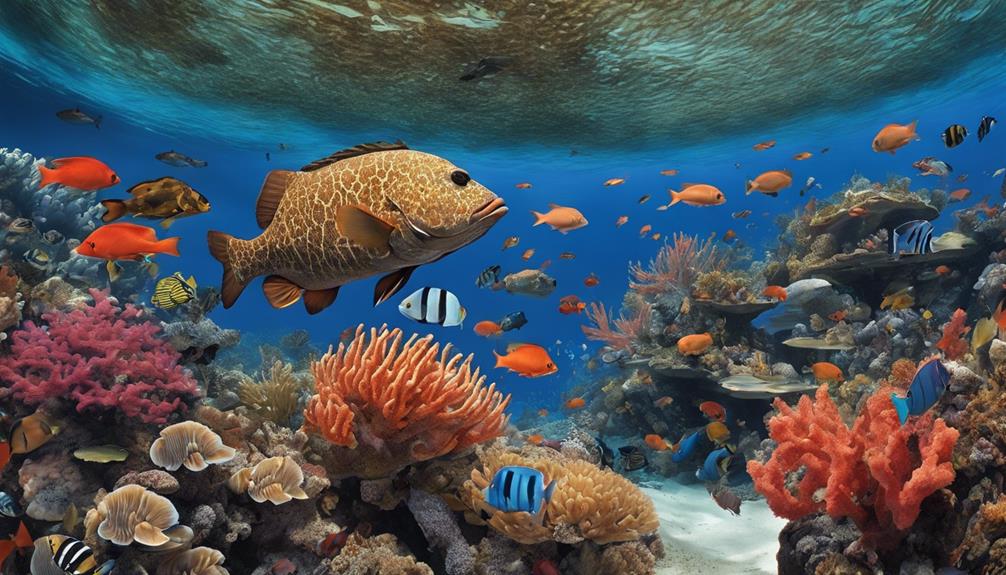
To effectively locate grouper for fishing, exploring their preferred habitats near structures like reefs, wrecks, and ledges is essential. Grouper are typically found in both shallow and deep waters where there are plenty of hiding spots like caves and crevices. These areas provide grouper with opportunities to ambush their prey, making them prime locations for anglers.
Whether in offshore or inshore waters, grouper are adaptable and can be targeted by anglers with varying preferences. By understanding the habitat preferences of different grouper species, anglers can greatly improve their chances of locating these elusive fish.
Rocky bottoms and underwater structures are key areas to explore when searching for grouper, as these environments attract and provide ideal conditions for them to thrive. By focusing on these habitats, anglers can increase their chances of encountering grouper and having a successful fishing experience.
Comparing Grouper Traits
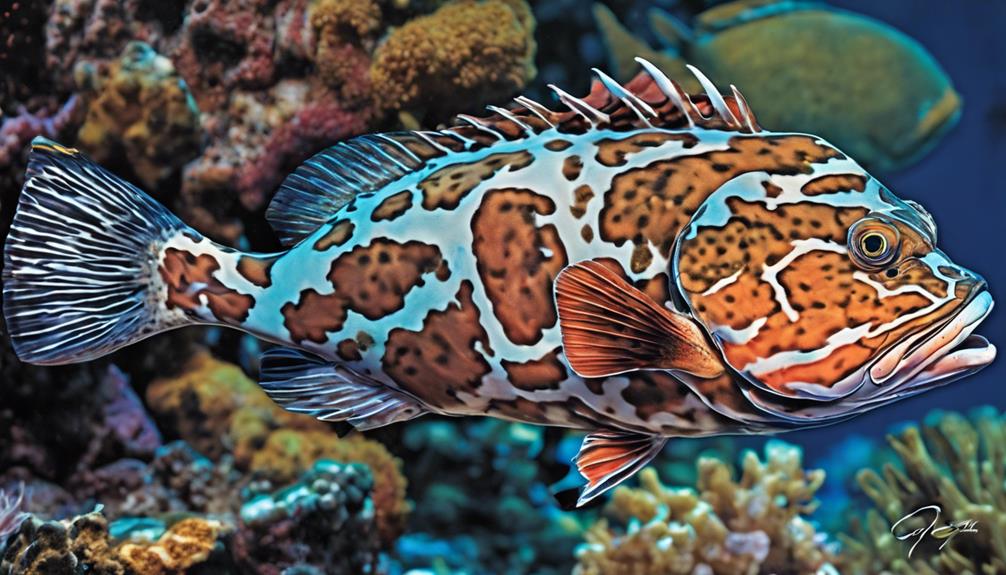
When comparing grouper traits, it's crucial to consider their size and habitat preferences. Groupers come in a variety of sizes, with some species growing over 8 feet long.
Their feeding behavior is also significant, as they use their powerful jaws and teeth to ambush and consume prey whole.
Size and Habitat
Exploring the size and habitat preferences of various grouper species reveals a fascinating diversity in their characteristics and behaviors. Groupers come in a range of sizes, with some growing up to 7 feet long and weighing over 800 pounds. These impressive fish can be found in various environments, from shallow coastal waters to deep offshore reefs and rocky bottoms.
Groupers have a strong affinity for structured habitats like coral reefs, wrecks, and underwater caves, using them as strategic locations to ambush their prey. Each grouper species has its unique habitat preferences; some thrive in sandy areas, while others prefer rocky ledges. Understanding the size and habitat preferences of different grouper species is essential for effectively targeting them during fishing expeditions.
Feeding Behavior
Groupers exhibit diverse feeding behaviors, showcasing their adaptability and predatory prowess in various marine ecosystems. These opportunistic feeders have a varied diet, consuming fish, crustaceans, and cephalopods. With their ambush predation technique, groupers patiently wait for unsuspecting prey before swiftly striking with their large mouths and powerful jaws.
Some species display territorial behavior, fiercely defending their feeding grounds from other predators. Anglers can benefit from understanding these feeding habits, as it helps in selecting the right bait and fishing methods for a successful catch. By observing and learning about grouper feeding behavior, one can appreciate the complexity and efficiency of these fascinating marine predators.
Identifying Grouper Species
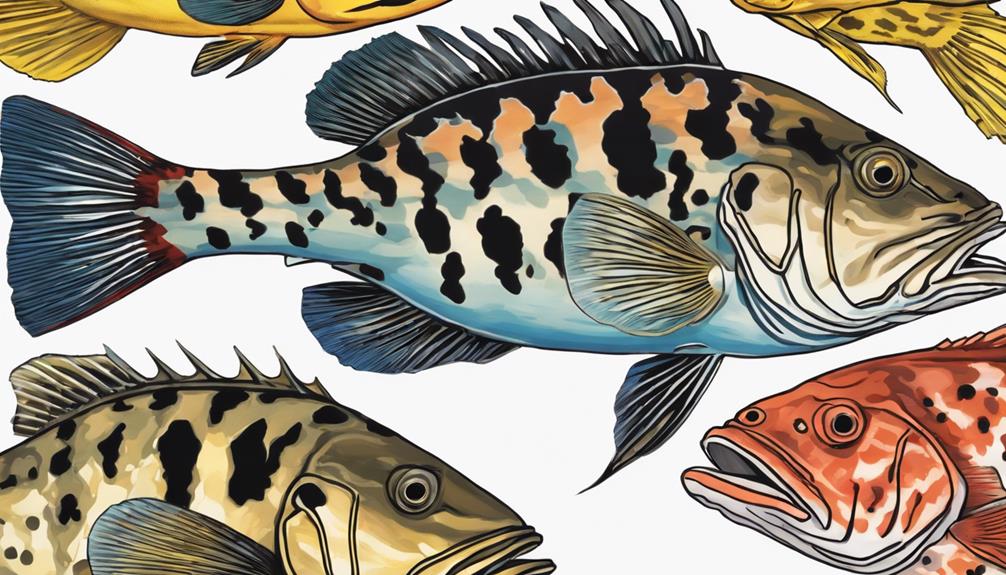
When identifying grouper species, it's essential to take into account their size variations, as groupers can range from a few pounds to over 800 pounds.
Understanding the habitat preferences of different grouper species is also vital for successful identification, as these fish inhabit various environments like reefs, wrecks, and mangroves.
Grouper Size Variations
Identifying different grouper species can be challenging due to their significant size variations. Grouper sizes range widely, with some species growing over 8 feet long and weighing hundreds of pounds. Common types like Gag, Red, Black, and Goliath Grouper have distinct size ranges.
Gag Grouper typically measure between 20 to 60 inches, while Red Grouper can reach up to 42 inches in length. Black Grouper are known to grow as long as 52 inches, and the massive Goliath Grouper can exceed 8 feet and weigh up to 800 pounds.
Recognizing these size differences is essential for proper identification and adherence to fishing regulations. Understanding the various sizes of grouper species enhances our ability to appreciate and protect these magnificent fish.
Grouper Habitat Preferences
Having discussed the size variations of different grouper species, it becomes imperative to understand their distinct habitat preferences in order to effectively locate and target these elusive fish. Grouper species exhibit diverse habitat choices, with each species favoring specific environments.
Red Grouper are commonly found in shallow waters up to 300 feet, while Gag Grouper prefer deeper waters up to 500 feet. Black Grouper tend to inhabit rocky ledges and wrecks, contrasting with Goliath Grouper, which favor mangrove roots and structures. Warsaw Grouper typically dwell in deep waters exceeding 600 feet, and Scamp Grouper are often associated with live bottom habitats.
Fishing Techniques for Grouper
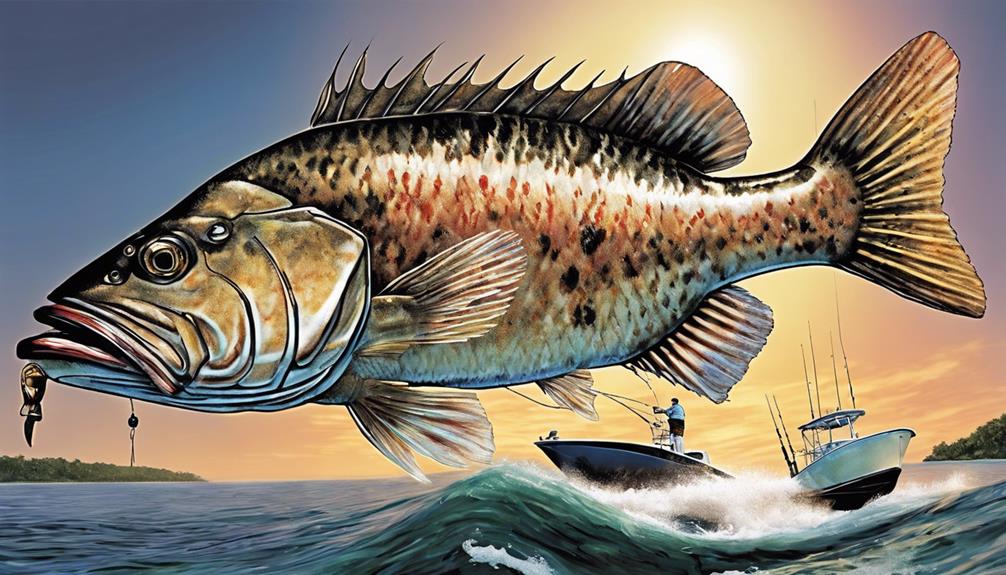
To reel in Grouper successfully, one must utilize heavy tackle and strong lines to match their powerful fighting abilities. When targeting Grouper, it's crucial to focus on structures like reefs, wrecks, and rock piles where they seek shelter and ambush prey.
Employing techniques such as vertical jigging, using live bait, or trolling can be effective in enticing Grouper to bite. Patience is key when fishing for Grouper, as they may take their time to locate and strike. Once hooked, be prepared for a challenging battle, as Grouper are renowned for their strength and determination.
- Heavy Tackle and Strong Lines: Match the power of Grouper for a successful catch.
- Target Structures: Focus on reefs, wrecks, and rock piles where Grouper hide.
- Technique Variety: Experiment with vertical jigging, live bait, and trolling methods.
- Patience Pays Off: Stay patient as Grouper may require time to commit to the bait.
Conservation Efforts for Grouper
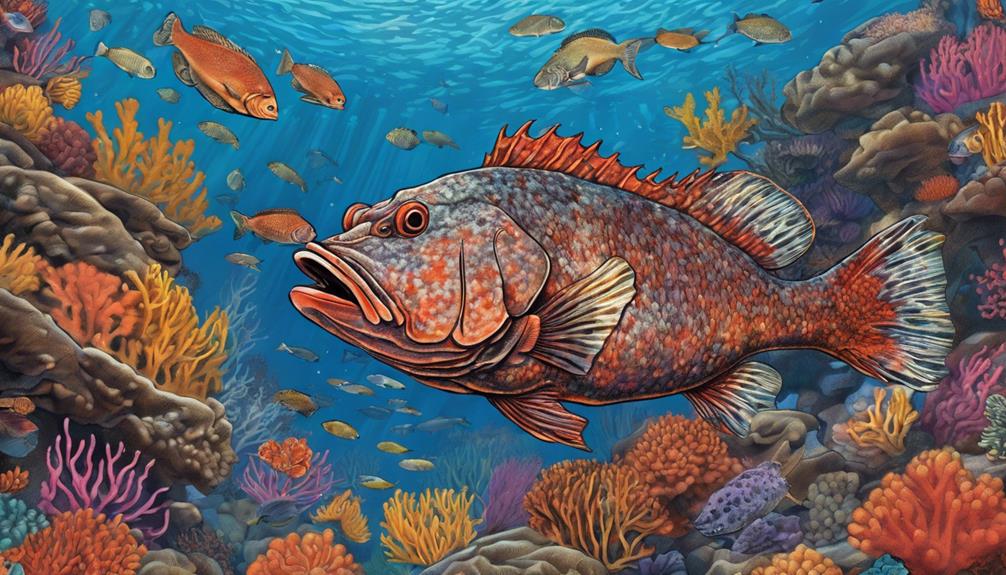
In our ongoing efforts to protect Grouper populations, we implement various conservation strategies to guarantee their sustainability. Grouper species face threats from overfishing due to their slow growth and late maturity, making it essential to enact measures such as size and bag limits, closed seasons, and marine protected areas. These regulations help control grouper fishing activities, ensuring their numbers can replenish.
Collaborative initiatives involving fishermen, scientists, and policymakers work together to safeguard sustainable grouper populations. By incorporating bycatch reduction devices and gear modifications, accidental catches of grouper during fishing are minimized, aiding in their conservation.
Monitoring programs play a crucial role in tracking grouper populations, evaluating the effectiveness of conservation efforts, and shaping future management decisions. By actively participating in these conservation endeavors, we can contribute to the preservation of these remarkable fish for generations to come.
Frequently Asked Questions
What Fish Is Most Similar to Grouper?
Snapper closely resembles grouper in appearance, habitat, and diet. They both thrive in offshore and reef environments, feeding on crustaceans and fish. Anglers targeting grouper can also catch snapper using similar techniques and bait in shared spots.
What Fish Are Grouper Related To?
I'll share the connections between grouper and other fish. Grouper are related to species like sea bass and rockfish, showing similarities to snapper and amberjack. Understanding these relationships can enhance our fishing strategies.
What Does Grouper Compare To?
Grouper compares to various fish like snapper in habitat preference and bass in hunting tactics. Similar to cod, they dwell near the bottom. Some species reach remarkable sizes like halibut. When hooked, grouper show strength akin to amberjack or tuna.
Is Mahi Mahi the Same as Grouper?
No, Mahi Mahi and Grouper are not the same. Mahi Mahi is a vibrant, fast swimmer with a sweet, firm taste. Grouper, on the other hand, boasts a camouflaged appearance and a buttery, flaky texture. Each fish offers a unique culinary experience.
Conclusion
So, remember to choose your grouper match wisely. Just like finding the perfect friend, you want to make sure you have similar traits and habits.
Explore their habitat, compare their characteristics, and identify their species before casting your line. By understanding their behavior and using the right fishing techniques, you can increase your chances of catching the perfect grouper.
And don't forget to support conservation efforts to protect these amazing fish for future generations!
